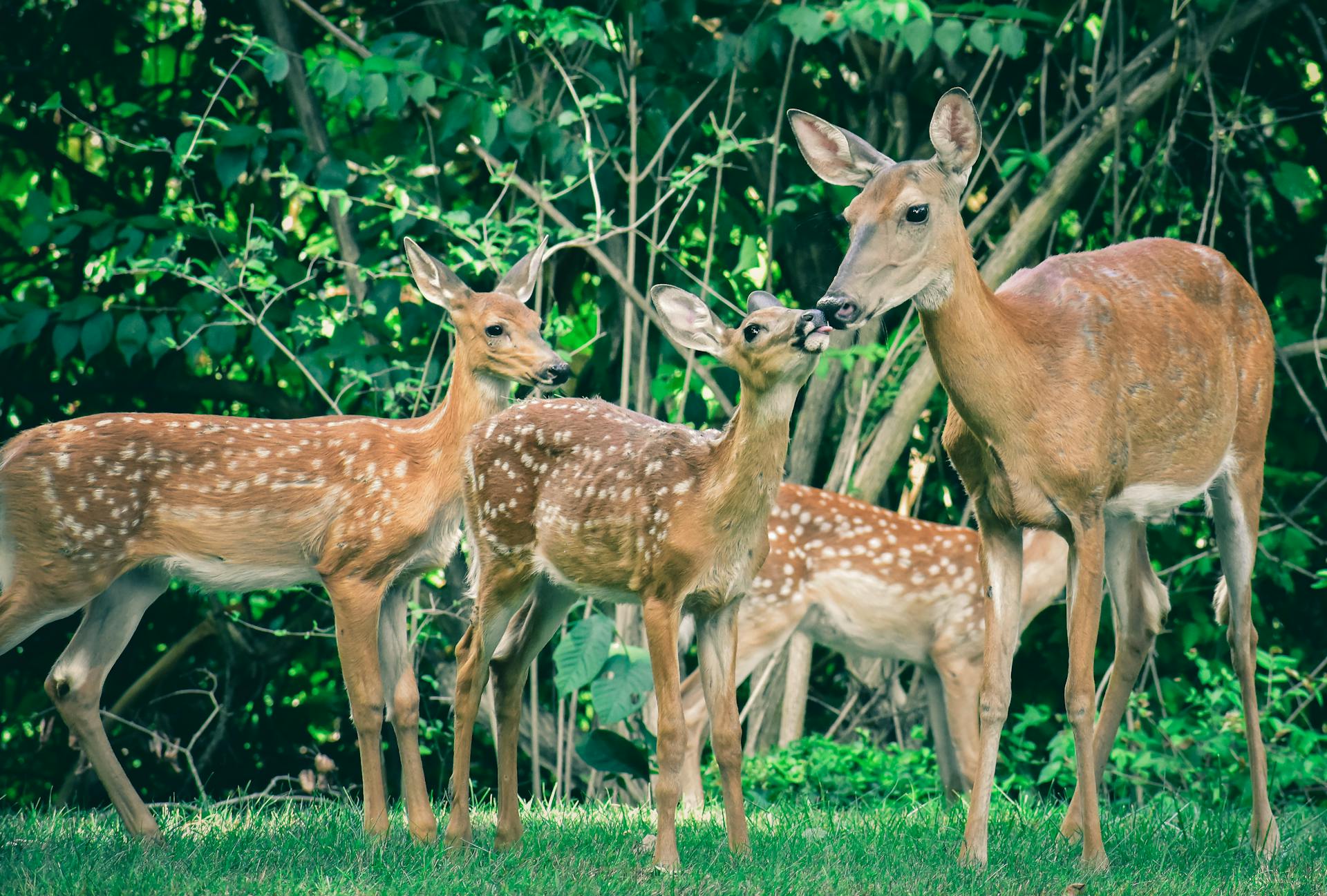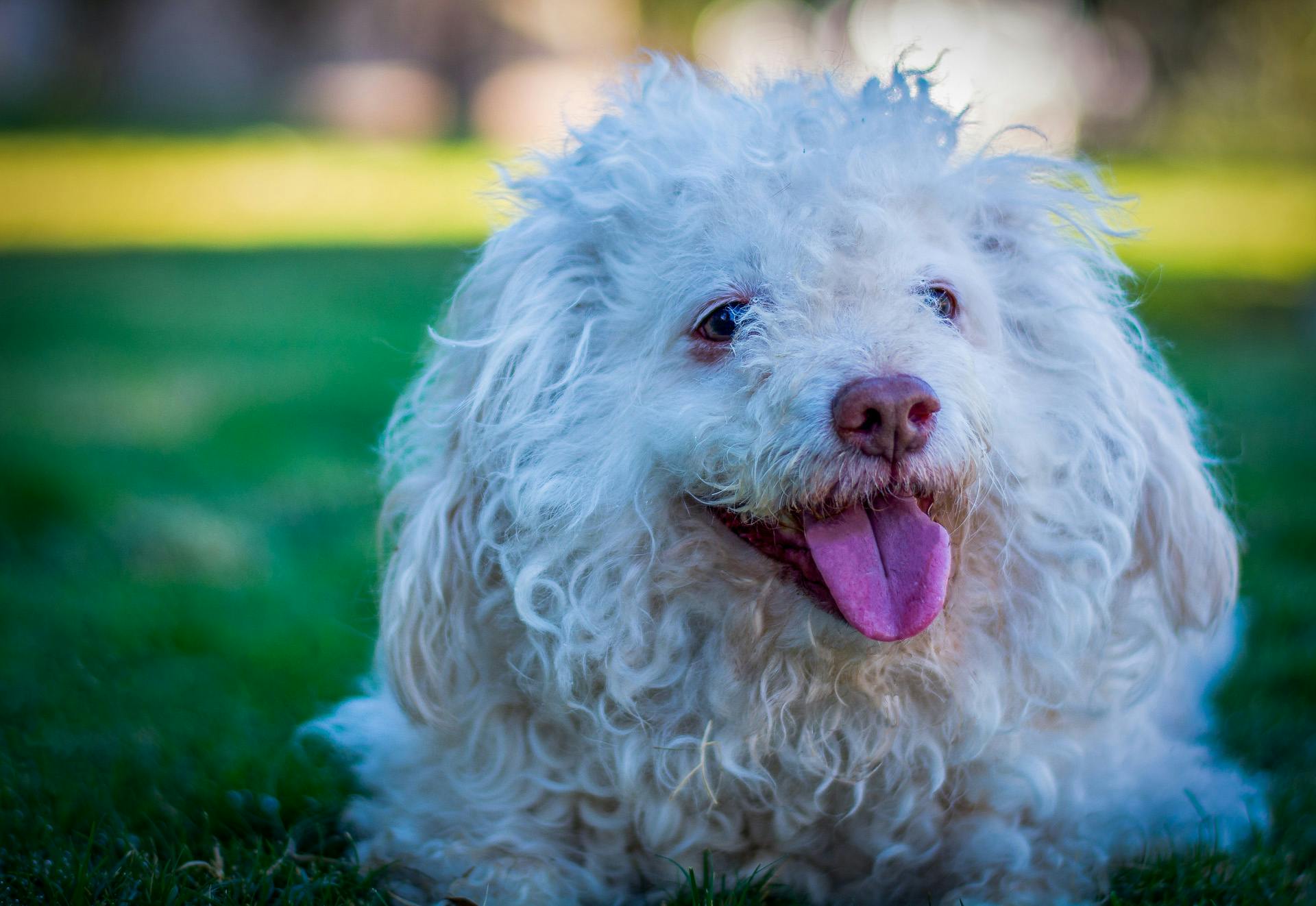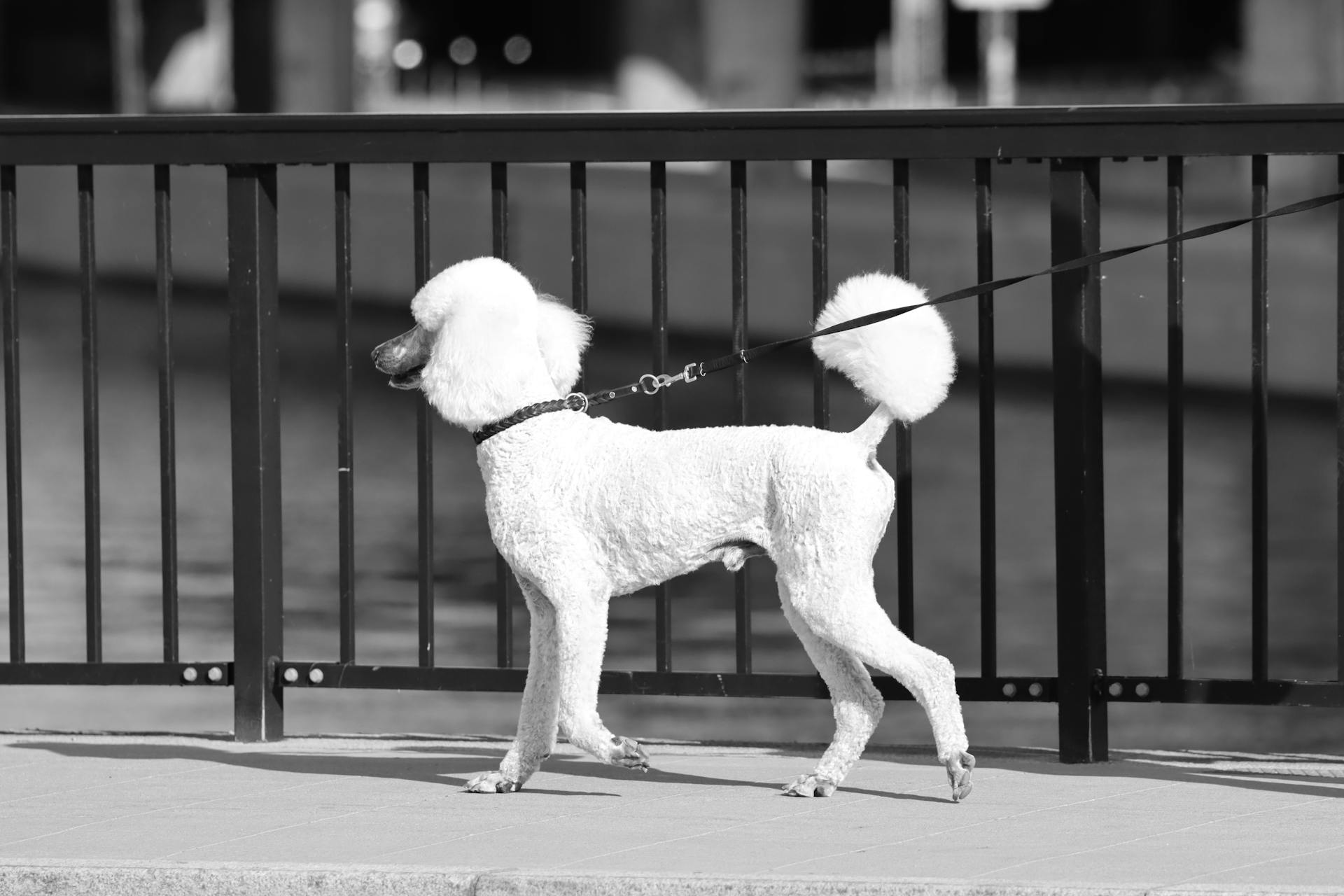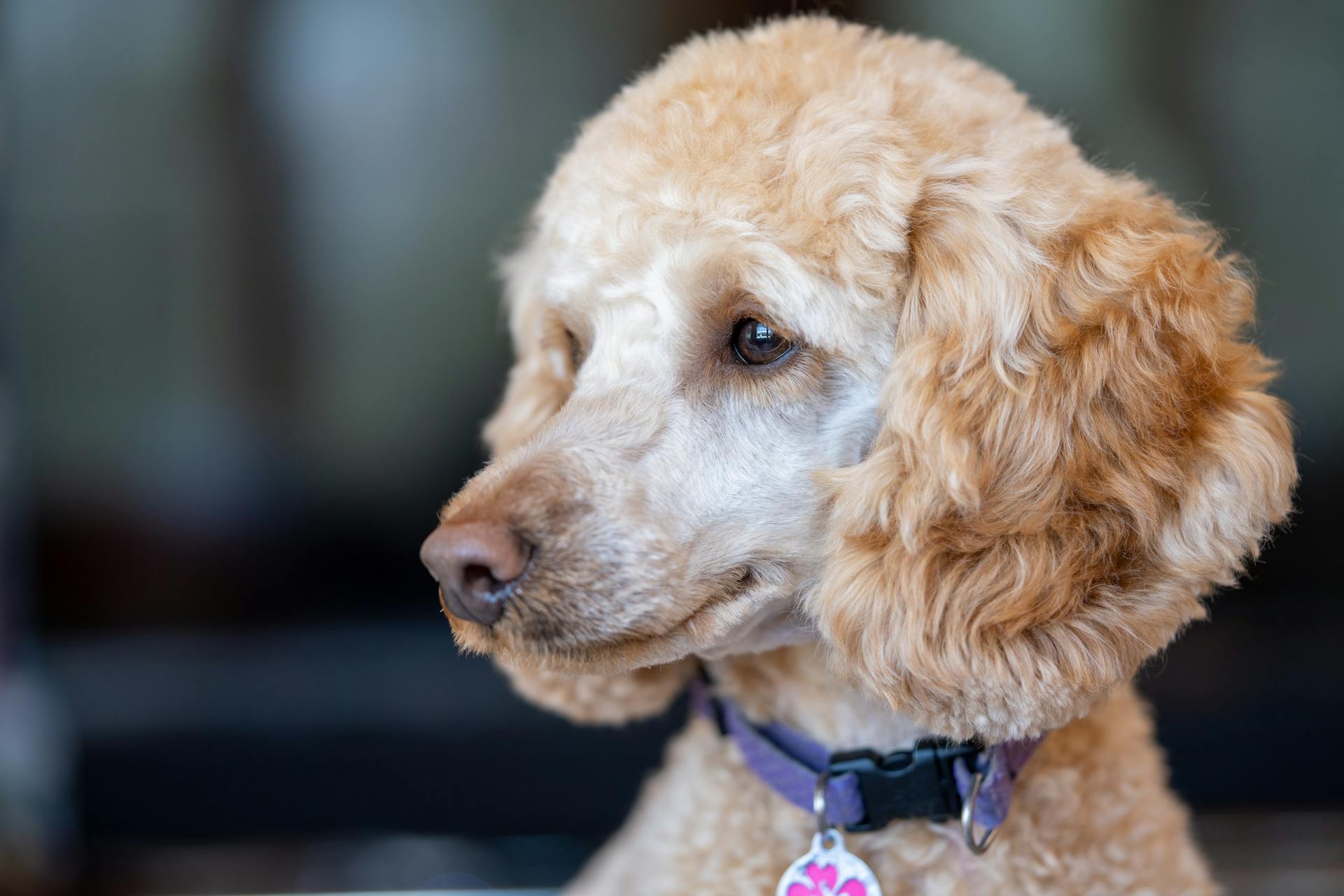
Congratulations on your pregnant standard poodle! This is an exciting time for you and your furry friend. Standard poodles are generally healthy dogs, but like all breeds, they can be prone to certain health issues during pregnancy.
Pregnant standard poodles typically carry between 2-6 puppies, with an average litter size of 4-5. The gestation period for standard poodles is approximately 60-65 days.
As your dog's belly grows, she'll need more frequent and nutritious meals to support her and her puppies' health. Feed a high-quality dog food that's rich in protein and calories, and consider adding a pregnancy supplement to her diet.
Regular veterinary check-ups are crucial during pregnancy to monitor your dog's health and detect any potential issues early on.
Suggestion: Standard Poodle Health Concerns
Pregnancy Signs and Symptoms
As you're expecting a litter of adorable standard poodle puppies, it's essential to recognize the signs of pregnancy in your furry friend. A pregnant standard poodle may exhibit an increase in appetite.
You may notice your poodle gaining weight, which is a common sign of pregnancy. A swollen belly is another indication that your poodle is expecting.
Some poodles may vomit and have a decrease in appetite for a few days in the first few weeks due to changes in hormones. This is usually a temporary condition, but it's always best to consult with a veterinarian to rule out any underlying health issues.
Pregnant standard poodles may also become more sluggish and rest more frequently, which can be a sign of pregnancy. Your poodle's stomach will quickly grow, firming up by week two and becoming visibly swollen by week four.
You may also notice that your poodle's mammary glands are bigger, including some nipples that may not have been visible before. This is a normal sign of pregnancy.
Here are some common signs of pregnancy in standard poodles:
- Increase in appetite
- Weight gain
- Swollen belly
- Tires more easily
- Nesting behavior
- More affectionate
- Irritability
Keep in mind that some poodles may exhibit these signs but may actually be experiencing a false pregnancy. It's always best to consult with a veterinarian to confirm pregnancy and rule out any underlying health issues.
Care
Caring for a pregnant standard poodle requires attention to her nutrition, exercise, and veterinary check-ups. A well-balanced diet is essential for her health and the growth of her puppies.
Proper Nutrition is key, and you should continue to feed her a good quality dog food, unless your veterinarian advises otherwise. Increasing her food intake gradually in the last weeks of her pregnancy is recommended, but it's best to start with small, frequent meals.
Regular Exercise is also important, but be mindful not to overdo it, as this can cause discomfort. Your veterinarian can provide guidance on the right amount of exercise for your pregnant poodle.
Veterinary Check-Ups are crucial to monitor the health of the mother and her puppies. Your veterinarian may suggest extra nutrients or drugs to ensure a healthy pregnancy.
Here are some essential tips to keep in mind:
- Feed a nutritious, well-balanced food, and consider increasing her food intake gradually as her pregnancy progresses.
- Encourage regular exercise, but avoid overexertion.
- Regular veterinary check-ups will help monitor the health of the mother and her puppies.
- Prepare a safe and comfortable place for delivery, and have a whelping box, clean towels, and other necessary materials on hand.
By following these guidelines, you can help ensure a healthy pregnancy for your standard poodle and her puppies.
Whelping and Labor
As your Standard Poodle's due date approaches, it's essential to get ready for the birth of the puppies. You'll need to have a whelping box or a safe, warm, and easily cleaned location for your dog to have her puppies.
A whelping box should be draft-free and easy for the mother to get in and out of, but not the puppies. You'll also want to make sure it's in a quiet area of the house, but accessible for you in case you need to assist.
Here are some essential items to have on hand for whelping: Lots of newspaper for easy cleanupNon-skid bath mats for bedding after whelping is doneDry, clean towels to clean the puppiesPaper towels to help with clean upThermometer to check your dog’s temperatureClean, sterilized scissors to cut the umbilical cordsUnwaxed dental floss to tie off the umbilical cordsIodine to clean the puppies’ abdomens after the cord is cutHeat lamp to keep the puppies warmBulb syringe to clean puppies’ nose and mouthA baby scale in ouncesHoney or light corn syrup
It's also a good idea to have a veterinarian's phone number and the number of a nearby emergency clinic on hand, just in case.
Intriguing read: Can Siberian Huskies Live in Warm Weather
Whelping
Whelping is a critical process, and being prepared is key. It's essential to have a whelping supply checklist handy, which should include items like newspaper, non-skid bath mats, dry towels, and a thermometer.
A whelping box is a must-have, providing a safe and warm space for your dog to give birth. You can purchase a whelping box or even use a small children's plastic swimming pool. The box should be easy for the mother to get in and out of, but not the puppies.
It's crucial to introduce your dog to the whelping box before whelping, so she feels comfortable and secure. If you don't, she might decide to deliver elsewhere, like your closet.
Having a whelping kit on hand is vital, including clean gloves, towels, and necessary supplies like clean cloths, floss, or thread for tying off umbilical cords.
Here's a list of essential items to include in your whelping kit:
- Lots of newspaper to line the whelping box
- Non-skid bath mats for bedding after whelping is done
- Dry, clean towels to clean the puppies
- Paper towels to help with clean up
- Thermometer to check your dog's temperature before whelping
- Clean, sterilized scissors to cut the umbilical cords
- Unwaxed dental floss to tie off the umbilical cords
- Iodine to clean the puppies' abdomens after the cord is cut
- Bulb syringe to clean puppies' nose and mouth
- A baby scale in ounces
- Honey or light corn syrup
- Veterinarian's phone number and the number of a nearby emergency clinic
Having a helper around during whelping can be a big plus, especially if any problems develop. Keep a careful eye on your dog and offer her the support she needs.
Possible Labor Complications
Possible Labor Complications can be a source of stress for any dog owner. If your dog's rectal temperature dropped more than 24 hours ago and labor isn't starting, it's time to call your veterinarian.
Severe discomfort in the mother is another red flag. If she doesn't deliver the first puppy 2 hours after contractions begin, especially if she has passed green discharge, seek veterinary attention immediately.
More than 2 hours passing between the delivery of puppies or strong contractions for an hour without a birth is also a cause for concern. This can be a sign that something is amiss and your vet should be notified.
Trembling, collapsing, or shivering in the mother are warning signs of serious complications that could put both the bitch and the puppies at risk.
A dark green or bloody fluid after the first puppy is normal, but if this happens before the first puppy, it's a sign to call the vet.
If your dog shows no signs of whelping 64 days after her last mating, it's time to contact your veterinarian.
Curious to learn more? Check out: Boarding Dog for First Time
Pregnancy Preparation and Planning
As your Standard Poodle's due date draws near, it's essential to get ready for the birth of the puppies. You'll notice a significant enlargement of her breasts and nipples, and milky fluid as the milk glands develop and enlarge. Her abdomen will increase in size and may sway a little as she walks.
Design a roomy box or a lined kiddie pool to ensure the comfort and safety of your new Standard Poodle puppy during the birthing process. Have a heating pad tucked beneath covers or sheets for warmth, a suction bulb for removing mucus, clean cloths, floss, or thread for tying off umbilical cords on hand.
It's a good idea to introduce your dog to the whelping box beforehand, so she feels comfortable and secure during the birthing process. If you don't, she might decide to deliver in a less ideal location, like your closet.
Preparing for Puppies
As your dog's pregnancy approaches, you'll notice significant changes in her body, including the enlargement of her breasts and nipples, and the development of milky fluid.
The abdomen will increase in size and may sway a little as she walks. At the end of the pregnancy, you might even be able to see or feel the puppies moving around inside the mother.
It's essential to prepare yourself and your dog for whelping, or puppy birthing, by setting up a whelping box. This should be a safe, warm, draft-free, and easily cleaned location for your dog to have her puppies.
You can purchase a whelping box or even use a small children's plastic swimming pool. The whelping box should be easy for the mother, but not the puppies, to get in and out of.
Your dog may prefer to have the whelping box in a quiet area of the house, but in an area that you can have easy access. It's crucial to introduce her to the whelping box beforehand to prevent her from delivering elsewhere.
You'll need to have another person with you to help keep the puppies warm or assist if needed during the whelping process.
Readers also liked: Cartoon Shih Tzu Drawing Easy
Predicting Puppy Numbers
A standard Poodle can have varying litter sizes, but the average range is typically between 5 to 8 puppies per litter.
The size of the parents can significantly impact the number of puppies born, with bigger breeds often producing larger litters.
On average, a litter of Standard Poodle puppies will have about seven puppies.
Crystal, a Standard Poodle, set a record in 2014 with her litter of sixteen puppies, showing that even with careful planning, there's always an element of surprise.
The average litter size for miniature poodles is about five puppies, and the smallest for toy poodles is three.
A litter's size depends on many factors, including the mother's age, size, health, and when she conceives.
Additional reading: Standard Poodle Crate Size
Minnesota Ties Record
The largest standard poodle litter was born in Minnesota, with 16 puppies squirming around after their mother, Crystal Diamond RD-Crystal, gave birth.
The mother, Crystal, didn't look bigger than average, so the family was shocked when she kept having babies.
The litter of 16 puppies is believed to have tied a record for the largest standard poodle litter.
The mother, Crystal, had no complications during labor and the family watched over her as she gave birth over a 24-hour period.
The puppies were all nursed and fed properly, and not a single one was lost.
The family had to put the puppies on a schedule for feedings to ensure they all nursed, and they used strings to keep track of which puppies were on which schedule.
The average litter size for miniature poodles is five puppies, while standard poodles typically give birth to six.
Crystal was bred via artificial insemination to a miniature poodle named Rusty, making their offspring moyen, or medium, poodles.
Explore further: Pick of the Litter (film)
Pregnancy Health and Monitoring
As a poodle owner, it's essential to keep a close eye on your pregnant standard poodle's health and well-being. Monitoring her behavior, appetite, and appearance can help you detect any potential issues early on.
Regular veterinary checkups are crucial during pregnancy, ideally every few weeks to ensure the mother's overall health and the puppies' development.
The mother's health and age can significantly impact the size of the litter. A healthy and younger mother has a better chance of having a healthy litter.
You can monitor your poodle's pregnancy through various methods, including diagnostic testing and observing her behavior. Some common signs of pregnancy include weight increase and nesting behavior.
Here are some methods to determine if your poodle is pregnant:
- Abdominal palpation: Your veterinarian can perform this test starting at around 28-30 days of gestation, feeling for fluid-filled sacks surrounding the fetus.
- Ultrasound: This test can detect fetal heartbeats and estimate the number of puppies between 25 and 35 days of gestation.
- Hormone test: Your veterinarian can perform a blood test to measure hormone levels, which can indicate pregnancy around 25-30 days of gestation.
- X-ray: This is one of the most effective ways to determine if a poodle is pregnant, but it's best done at 55 days or more to get an accurate count of the puppies.
Keep in mind that the timing of these tests is crucial, and it's essential to consult with your veterinarian to determine the best approach for your poodle's pregnancy.
Stages of Development
During the first two weeks of pregnancy, fertilization and implantation occur, and you may not notice any physical changes in your dog.
Your Poodle's nipples may begin to darken and enlarge around week 3, and she may start to experience morning sickness.
You can expect your Poodle's belly to start swelling around week 4, and if you gently press on it, you might be able to feel the babies. An ultrasound may also be used by your veterinarian to verify the pregnancy.
The skeletons of the puppies will begin to form around week 5, and your Poodle's belly will continue to expand. She may also appear to be more worn out than usual.
As the puppies develop, you may notice them moving about inside the uterus and their hair starting to develop around week 6. Your Poodle's tummy will start to get visibly bigger, and you might need to start feeding her more frequently.
Your Poodle may start nesting and gathering toys or blankets in anticipation of the birth around week 7. Additionally, you might notice the puppies moving around more.
By week 8, your Poodle will have a very huge tummy and may find it difficult to move around comfortably. She needs a whelping box, and you should keep a close eye out for symptoms of labor.
During the final weeks of pregnancy, your Poodle may lose her appetite and become more loud as she goes through labor.
Discover more: Cost of Boarding a Dog for a Week
Frequently Asked Questions
What is the best age for a Poodle to get pregnant?
For optimal health and breeding success, a female Poodle should be at least 2 years old before getting pregnant. Breeding too early can have long-term consequences, so it's best to wait until she reaches maturity.
Sources
- https://www.akc.org/expert-advice/dog-breeding/dog-pregnancy-care-prep/
- https://www.jamestownsun.com/news/oodles-of-poodles-minnesota-dog-ties-record-for-largest-litter
- https://dogpregnancycal.com/poodle-pregnancy/
- https://dogsworldhub.com/how-long-are-poodles-pregnant/
- https://dogsworldhub.com/poodle-pregnancy-and-litter-size/
Featured Images: pexels.com


